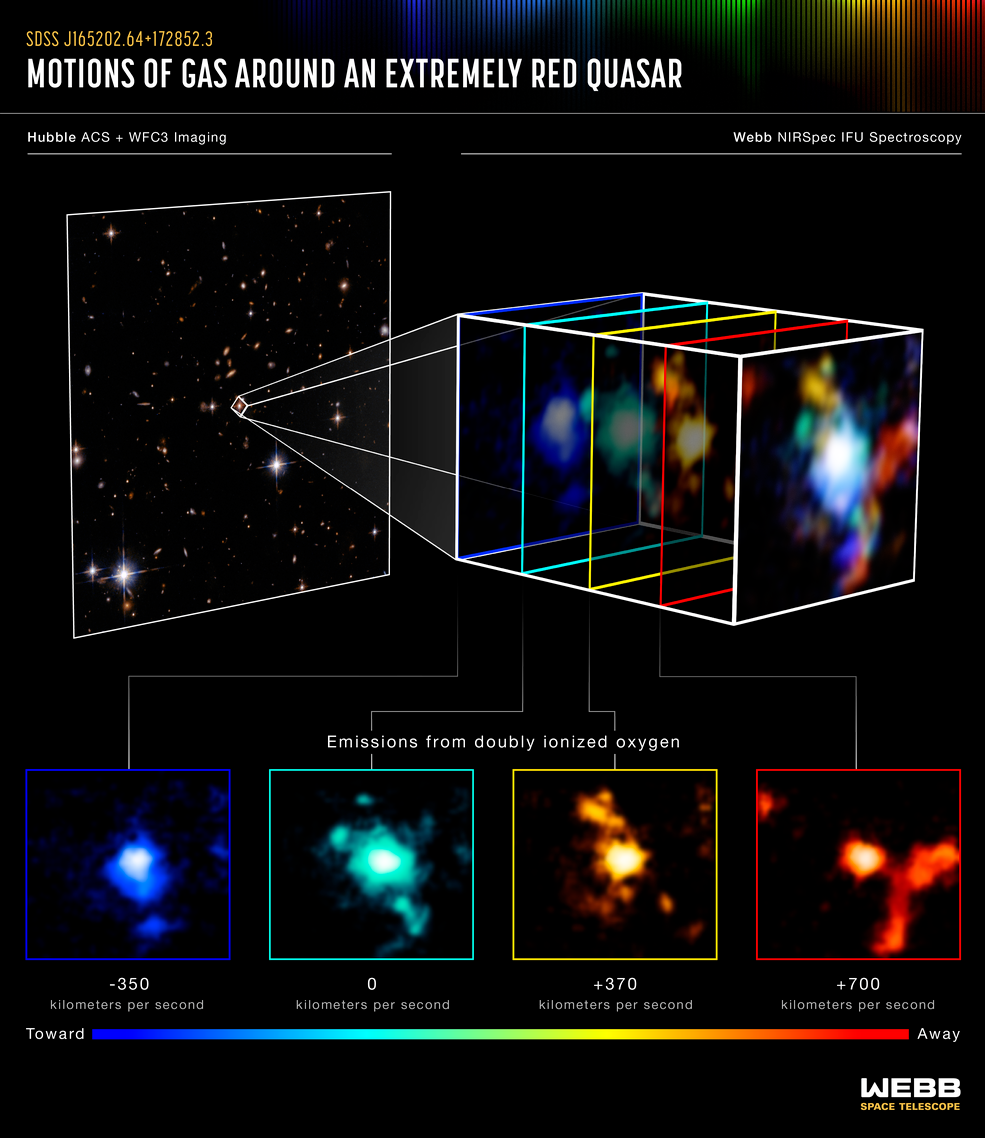Using NASA’s James Webb Space Telescope, astronomers studying the early universe have unearthed an astonishing discovery: a cluster of massive galaxies that are developing around an incredibly red quasar.

At left, the quasar SDSS J165202.64+172852.3 is highlighted in a Hubble Space Telescope image taken in visible and near-infrared light. The images on the right and at bottom present new observations from the James Webb Space Telescope in multiple wavelengths. They demonstrate the distribution and motions of gas within a newly observed galaxy cluster around the central quasar. Image Credit: NASA, ESA, CSA, STScI, D. Wylezalek (Heidelberg Univ.), A. Vayner and N. Zakamska (Johns Hopkins Univ.) and the Q-3D Team
The discovery will lead to a better understanding of how galaxy clusters in the early universe combined to build the cosmic web that exists today.
A tight area with a supermassive black hole at the galaxy’s center is known as a quasar, a specific type of active galactic nucleus (AGN). The quasar is so bright that it outshines every star in the galaxy as a result of gas falling into a supermassive black hole.
It took Webb 11.5 billion years to discover the quasar, designated SDSS J165202.64+172852.3. In addition to its naturally occurring red color, the galaxy’s extreme distance has also caused its light to be redshifted, giving it an exceptionally red color.
Webb was, therefore, well equipped to study the galaxy in detail owing to its unmatched sensitivity to infrared wavelengths.
One of the most powerful galactic nuclei ever observed at such a considerable distance is this quasar. Scientists had hypothesized that the quasar’s intense emission could produce a “galactic wind,” which would force free gas out of its host galaxy and perhaps have a significant impact on future star formation there.
The researchers utilized the telescope’s Near Infrared Spectrograph (NIRSpec) to look into the movement of the gas, dust, and stellar material in the galaxy. This sophisticated instrument examines the movement of numerous outflows and winds surrounding the quasar using a method known as spectroscopy.
Webb can concurrently study the quasar, its galaxy, and the larger environs due to NIRSpec’s ability to simultaneously acquire spectra over the telescope’s whole field of view rather than just from one place at a time.
The quasar’s intense outflows were previously noted by NASA’s Hubble Space Telescope and other observatories, and astronomers conjectured that its host galaxy might be merging with an unidentified companion.
However, the researchers did not anticipate that Webb’s NIRSpec data would show that there were at least three other galaxies spinning around it, not just one. The movements of all this surrounding material could be tracked with the spectra covering a wide region, which led to the discovery that the red quasar was actually a part of a dense knot of galaxy formation.
There are few galaxy protoclusters known at this early time. It is hard to find them, and very few have had time to form since the big bang. This may eventually help us understand how galaxies in dense environments evolve. It is an exciting result.
Dominika Wylezalek, Study Lead and Astronomer, Heidelberg University
The team was able to confirm and demonstrate the connections between three galactic companions to this quasar using the images from NIRSpec. There could be even more, according to the archived Hubble data.
The quasar and its galaxy were chosen for this study of its outflow and the impact on its host galaxy since Hubble’s Wide Field Camera 3 images had revealed extended material encircling it. As a result of Webb’s precise imaging, the team now believes they could have been seeing the center of an entire cluster of galaxies.
Our first look at the data quickly revealed clear signs of major interactions between the neighboring galaxies. The sensitivity of the NIRSpec instrument was immediately apparent, and it was clear to me that we are in a new era of infrared spectroscopy.
Andrey Vayner, Postdoctoral Fellow, Physics and Astronomy, Johns Hopkins University
The fact that the three verified galaxies are circling one another at such high speeds suggests that a significant amount of mass is present. The team thinks this is one of the densest known regions of galaxy formation in the early universe because of how densely they are clustered in the area surrounding this quasar.
Wylezalek added, “Even a dense knot of dark matter is not sufficient to explain it. We think we could be seeing a region where two massive halos of dark matter are merging together.”
It is believed that dark matter, an unobservable element of the cosmos, forms a “halo” around these stars, holding galaxies and galaxy clusters together.
The research of Wylezalek’s team is a part of Webb’s early universe studies. The telescope is already being used to study how the first galaxies began and evolved, along with how black holes emerged and affected the structure of the universe, owing to its unmatched capacity to see back in time.
Follow-up studies into this surprising galaxy proto-cluster are being planned by the researchers in an effort to learn more about how dense, chaotic galaxy clusters like this one emerge and how the active, supermassive black hole at its center affects them.
These findings will be published in The Astrophysical Journal Letters. The study was completed as part of Webb’s Early Release Science program #1335.